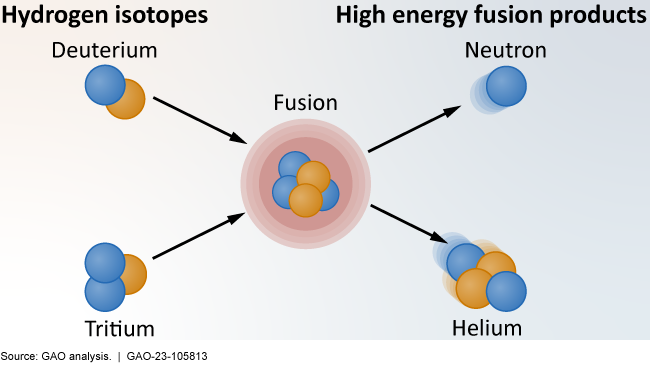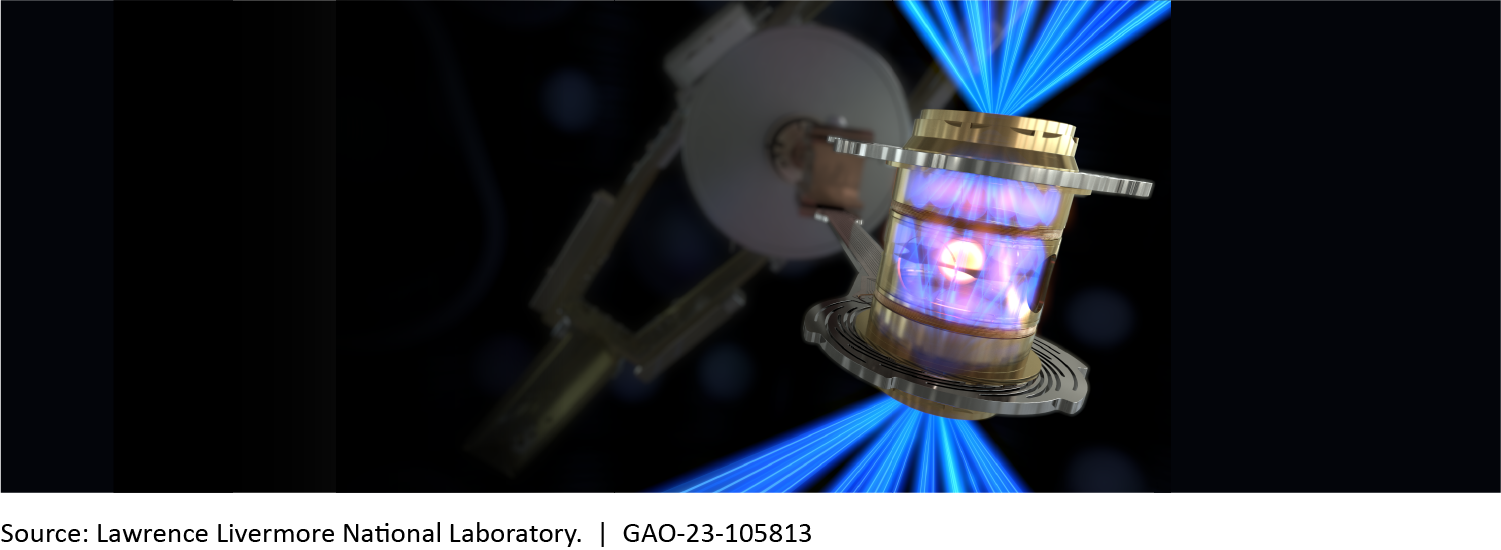Fusion Energy: Potentially Transformative Technology Still Faces Fundamental Challenges
Fast Facts
Nuclear fusion could produce electricity without carbon emissions or long-lasting nuclear waste. A 2022 experiment achieved a key milestone on the path to viable fusion energy: it was the first experiment in which the fusion reaction produced more energy than the energy injected into it.
However, this technology faces challenges before it can produce commercial electricity. For example, new materials will need to be developed that can withstand the extreme conditions expected inside a power plant using fusion energy.
In this technology assessment, we've developed policy options that could help address such challenges.
Fusion Energy Combines Elements Into Heavier Elements

Highlights
What GAO Found
Nuclear fusion, the process that powers the sun and other stars, could produce electric power without carbon emissions, long-lived nuclear waste, or risk of meltdowns. Researchers and companies are pursuing many different concepts for fusion energy and have reported recent progress, such as the development of high-temperature superconducting magnets that could make fusion devices much more compact. Also, in 2022, an experiment at the National Ignition Facility achieved a key scientific milestone, generating more energy from a fusion reaction than the amount of direct energy spent to start the reaction.
National Ignition Facility

However, several challenges must be overcome to achieve commercial fusion, and stakeholders’ projections of this timeline range from 10 years to several decades. One key scientific challenge is in the physics of plasmas, the state of matter needed for fusion. Researchers do not fully understand the behavior of burning plasmas, those whose main source of heat is from the fusion reaction itself rather than an external source. Researchers have made advancements in this area but lack sufficient experimental data to validate their simulations. One key engineering challenge is the development of materials that can withstand fusion conditions for decades, such as extreme heat and neutron damage, and no facility exists where materials can be fully tested. More generally, the task of extracting energy from fusion to provide an economical source of electric power presents several complex systems engineering problems that have yet to be solved.
Public and private sector misalignments, regulatory uncertainty, and other factors also present challenges to fusion energy development. One area of misalignment is research priorities. Public sector efforts prioritize basic science, but fusion energy development requires an additional emphasis on technology and engineering research. Another factor is regulatory uncertainty, which could slow development of fusion energy, although developing appropriate regulations to ensure safety without constraining development is difficult. Doing so may require significant public engagement, but little is known about public perception of fusion energy in the U.S.
GAO developed four policy options that could help address these challenges or enhance the benefits of fusion energy. These policy options are provided to inform potential actions to address the public policy challenges identified in this technology assessment. They identify possible actions by policymakers, which include legislative bodies, government agencies, academia, industry, and other groups. See below for a summary of the policy options and relevant opportunities and considerations.
Policy Options to Help Address Challenges or Enhance Benefits of Fusion Energy
| Opportunities | Considerations | |
|---|---|---|
| Sustain current efforts (report p. 32) |
|
|
|
Align public and private efforts (report p. 33) Implementation approaches: Align programs, missions, and organizational structures with fusion energy development goals Expand use of public private partnerships Reduce barriers to collaboration Leverage international coordination |
|
|
|
Build shared assets for fusion energy (report p. 34) Implementation approaches: Support facilities that address scientific and engineering challenges Support workforce development Assess sources of critical supplies and manufacturing capabilities |
|
|
|
Engage the public in decision-making (report p. 35) Implementation approaches: Study public opinion through surveys and focus groups Educate through cross-sectoral forums Include affected communities in decision-making related to fusion facilities |
|
|
Source: GAO. | GAO-23-105813
Why GAO Did This Study
Fusion could address many energy challenges by providing abundant, safe, low-carbon energy. Researchers have achieved scientific and technological advancements in recent years. Fusion energy companies have received billions of dollars of private investment in addition to federal grants.
GAO conducted a technology assessment on (1) the status, potential benefits, and limitations of fusion energy, (2) challenges that might affect the development or use of fusion energy, (3) policy options that might help enhance the benefits or mitigate challenges associated with fusion energy.
GAO reviewed key reports and scientific literature; interviewed stakeholders from government, industry, and academia; held focus groups with members of the public; attended a conference on issues related to fusion energy; and convened a meeting of experts in collaboration with the National Academies of Sciences, Engineering, and Medicine. GAO is identifying policy options in this report.
For more information, contact Brian Bothwell at (202) 512-6888 or bothwellb@gao.gov.
